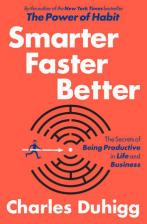How to Turbocharge Your Productivity: An Interview with Bestselling Author Charles Duhigg
Author Charles Duhigg, whose new book Smarter, Faster, Better: The Secrets of Being Productive in Life and Business, talks with Get-It-Done Guy about how to zoom forward on your goals with mental models and a better way to innovate.

Mental models
Having and using a rich set of mental models is one of the major tools used by highly productive people.
Making a story for your day
- The most productive people are the ones who discipline their thinking and focus a little bit better. They can train their brains to switch motivation on and off.
- Building a mental model means we tell ourselves a story about what’s going on as happening, to create an expectation for our reality.
- We become practiced with what we need to focus on and what we can safely ignore through pre-rehearsing what will happen in a given situation.
- If you’re on the train, you can make up a mental story of your day hour by hour. Will you shut your email off from 11–12 am to work on a memo without distraction? How will you look when you present during that meeting?
Wanting closure
Closure is a mixed blessing. People with a high need for closure are good at following through and getting things done. But too much closure can lead to blinders, and a lack of flexibility when it’s most needed.
- The most successful people love a certain degree of closure from tasks they complete or goals they reach.
- You can gain this sense of closure from to do lists.
- Put a stretch goal at the top of the page which will push you to achieve something higher.
- List the steps to get there underneath, using a SMART goal to achieve the stretch goal.
- Ask yourself:
- Have I gotten closer to this ambition (The stretch goal)?
- Is it the right ambition?
- How am I going to start tomorrow morning?
- As you check things off, you’ll experience a feeling of closure which will drive you forward.
Cognitive tunneling
Labor saving devices save us labor, but they also lull us into a false sense of security. When we reach the limits of what we can do, we need to be able to switch into highly-functioning thinking that doesn’t depend on our devices.
- Nowadays, people rely on cell phones for what their brains used to do for them.
- In many ways, our cognitive ability to create mental models of what we’re about to do has been hurt by cell phones and other distractions.
- Where you once stood in a line and thought about the day ahead of you, now you go to check Facebook or Twitter obsessively until you reach your coffee.
- Now, we think less and react more. What we want to be doing is working less, and thinking more.
- To beat this, take moments each day to run through a mind movie of how it’s all going to go. Instead of reaching for your cell phone, make a mind movie first so you know what you’re really going to get done.
Innovation doesn’t take tortured geniuses in a conference room, however.
Innovation
Innovation is quite the buzz word, but it’s a very real thing. New problems may require new solutions. But is there a way to cheat, and be innovative on demand? It appears so…
- Increasingly, jobs demand innovation on deadline.
- Innovation doesn’t take tortured geniuses in a conference room, however.
- The most successful innovators combine old ideas to create new ones.
- To do this, find the ideas in the genre or format you’re trying to create that you like the most.
- Then pick two or three that are your favorites and start trying to combine them into the mega-version of your favorite thing.
- Now, you have a new idea that you love, and others may love too.
You can find Charles Duhigg on the web at charlesduhigg.com.
This is Stever Robbins. Follow GetItDoneGuy on Twitter and Facebook. I run webinars and other programs to help people be Extraordinarily Productive, and build extraordinary careers. If you want to know more, visit SteverRobbins.com
Work Less, Do More, and Have a Great Life!






